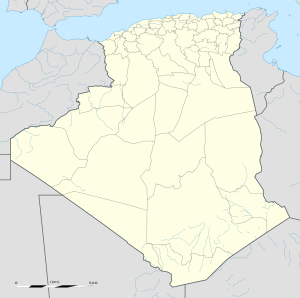Pont Sidi Rached
Coordinates: 36 ° 21 ′ 45 ″ N , 6 ° 36 ′ 49 ″ E
| Pont Sidi Rached | ||
|---|---|---|
| use | Road bridge | |
| Crossing of | Oued Rhumel | |
| place | Constantine (Algeria) | |
| construction | Arch bridge | |
| Longest span | 68 m | |
| Clear height | 103 m | |
| start of building | 1908 | |
| completion | 1912 | |
| planner | Paul Séjourné | |
| location | ||
|
|
||
The Pont Sidi Rached is an arch bridge in Constantine (Algeria) that connects the old town across the deeply cut gorge of the Oued Rhumel with the El Kantara district and the train station located there. For road traffic, it is the most important connection between the city center and the eastern parts of the city. It has a lane and a wide sidewalk in each direction.
The bridge is part of a 447 m long viaduct , which initially follows the steep slope of the old town with sixteen arches and a 30 m spanning slope bridge in two wide curves, then with the actual bridge with a span of 68 m spans the Oued Rhumel and in another , slightly narrower curve with a total of nine arches, you reach the avenue Ali Zaamouche on the other side. The arches on both sides of the bridge have a span of 16 m, the other arches have an opening of 8.80 m. The Pont Sidi Rached crosses the Oued Rhumel at a clear height of 103 m, making it the highest stone arch bridge in the world when it opened.
The bridge was built in the years 1908–1912 according to plans by the French engineer Paul Séjourné , who here repeated the conception of his much-acclaimed Adolphe Bridge in Luxembourg . The bridge therefore consists of two parallel stone arches , each 4 m wide , which are 4 m apart. These stone arches support a 12 m wide reinforced concrete bridge . This construction not only reduced the weight of the bridge. Above all, the arches could be built on two comparatively slim and light falsework , which, according to the system perfected by Séjourné, only supported themselves on the side of the abutments and were held at the required height by adjustable tension ropes, but did not require any supports reaching down to the valley floor .
Not only the bridge, but the entire viaduct were built according to this system.
The opening took place on April 19, 1912 in the presence of high French politicians, the same day on which the Pont Sidi M'Cid was also opened.
During the construction of the bridge, it was not possible to see that the slopes below and next to the viaduct were creeping in the ground. For the resulting influences on the horizontal curves of the reinforced concrete slab, no sufficient transition structures were provided that could have absorbed these movements, so that the bridge itself was affected. Since the slope movements obviously cannot be prevented, compensatory measures have to be carried out on the structure over and over again in order to prevent the bridge from collapsing.
Web links
- Le Pont de Sidi Rached on Constantine d'hier & d'aujourd'hui , Serge Gilard's private website
- Sidi-Rached Bridge. In: Structurae
- Sidi Rached Bridge on Highest Bridges.com

